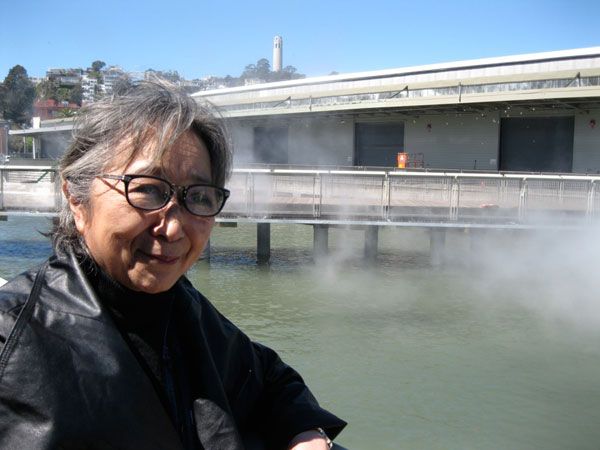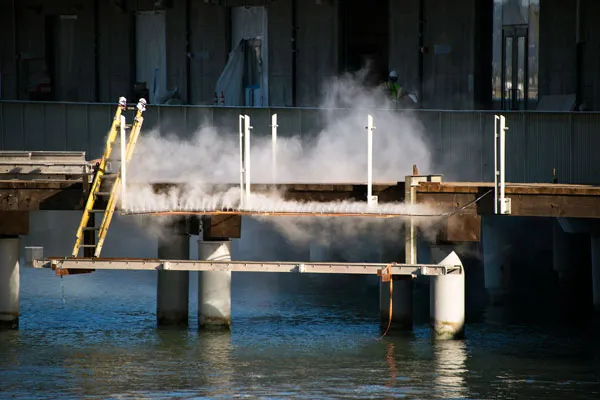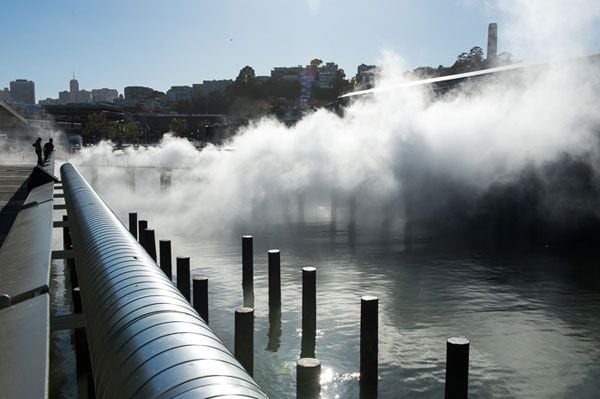An Artist Creates Artificial Fog in San Francisco
Fujiko Nakaya works with an unusual medium. The Japanese artist is sculpting fog clouds at the Exploratorium’s new site at Pier 15
/https://tf-cmsv2-smithsonianmag-media.s3.amazonaws.com/filer/Collage-Fog-Bridge-Nakaya-631.jpg)
Artist Fujiko Nakaya believes in the transformative power of fog.
The first time she realized that her fog sculptures could change a person’s memory was in 1976 during the run of Earth Talk, a fog sculpture made for the Biennale of Sydney, Australia. After seeing her sculpture, an electrician told her how he had taken his family to see the Blue Mountains in New South Wales. The mountain was fogged in at first and he couldn’t see it, but the fog cleared and the view of the mountain was the most beautiful thing he had ever seen.
“The instant he saw the fog it changed his experience, and I liked that very much,” explained Nakaya. It was then she understood that her sculptures could feed back to personal experience and improve a person’s feeling about fog. After the electrician’s story, she was determined to reach more people, and not just those in the art world.

For forty years, Nakaya has been creating public fog sculptures all over the world. Currently, she has seven projects going in five countries. Fog Bridge is her first in San Francisco, and is one of three inaugural outdoor artworks created for the new waterfront home of the Exploratorium.
The museum, which mixes science and art in its exhibits, was previously housed at the Palace of Fine Arts, but its new site—three times as big as the last, and at Pier 15—opens its doors to the public today. The 150-foot long Fog Bridge enshrouds pedestrians with fog for ten minutes every half hour; it will be lit at night, and so promises to be a spectacular sight. The bridge is located within the free, 1.5-acre outdoor area that encircles the Exploratorium and features artwork that honors the environment of the bay.

Nine days before the grand opening, Nakaya leaned against a railing to watch test runs of Fog Bridge. The 79-year-old artist was dressed comfortably in layers of black, though the day was warm enough for shorts. Coit Tower rose out of Telegraph Hill against a clear blue sky behind the bridge. Nakaya didn’t have to pull any wizard-like levers to release bursts of fog; the system is pre-programmed and designed to interact with real-time weather data. Each side of the bridge is divided into three sections and controlled by programmed valves in the pump room. For example, an eastern wind will prompt the valves to make fog on the east side of the bridge only.
In this way, an invisible wind is made visible with brush strokes of fog. The process starts with four pumps that force high-pressure water into pipes studded with 800 petite nozzles. At the tip of each nozzle is a hole six thousandths of an inch wide where the pressurized water is forced and meets a pin that explodes the water into droplets 15 to 20 microns wide. Nakaya developed the technology in 1970 with physicist Thomas Mee, and Mee Industries continues to use the patented technology for industrial and agricultural applications.

Nakaya’s fog is, of course, a simulation of the misty blankets that spread over the “cool gray city of love” each summer when cold oceanic surface water interacts with warm moist air offshore. As warm air rises over the inland valleys, the fog is pulled through the Golden Gate, providing needed summer moisture to coastal redwoods, the tallest trees in the world.
“I hope I’m doing homage to San Francisco fog,” said Nakaya adding, “that the bay fog will devour this fog sometimes.”
The Exploratorium sees itself as a place for tourists to learn about the Bay Area’s land and seascapes, and so some of its displays and artwork educate visitors about things like the tide cycle and fog. San Francisco’s fog, however, has declined 33 percent in the last 60 years, according to a study published in 2010 by UC Berkeley biology professor Todd E. Dawson and climate analyst Jim Johnstone, and the trend is expected to continue as climate changes. Dawson says they aren’t sure of the reason behind the decline, but that it may be due to warmer sea surface temperatures. “Fog formation is really about the contrast between temperatures,” he says. “If you warm the water up, the temperature difference goes down and the fog formation goes down with it.”
That said, Nakaya adds that fog always exists as water vapor even when we don’t see it. Only when conditions change is it visual.
In the first week that the museum is open, tens of thousands of people will walk across the bridge and be enveloped by fog. The sensation, I imagine, might feel like walking on clouds. Nakaya, reportedly, is particularly intrigued by the way that fog obscures one’s sight and heightens the other senses as a result. Perhaps this is why the artist believes that fog can improve memories and change thinking. “If you have even one little experience with fog, you start to see things differently,” said Nakaya.
The artist watched the artificial fog pour out of the northeast quadrant of the bridge where it hovered for a windless moment. “Nature is so complex. We can’t understand its complexity,” said Nakaya. “If you just tap one spot it will open up so many things and enlarge imaginations.”
Fog Bridge can be experienced at the Exploratorium through September 16, 2013.